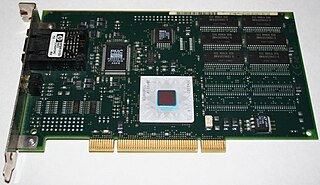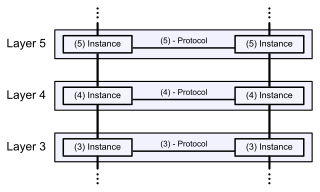
Asynchronous Transfer Mode (ATM) is, according to the ATM Forum, "a telecommunications concept defined by ANSI and ITU standards for carriage of a complete range of user traffic, including voice, data, and video signals". ATM was developed to meet the needs of the Broadband Integrated Services Digital Network, as defined in the late 1980s, and designed to integrate telecommunication networks. Additionally, It was designed for networks that must handle both traditional high-throughput data traffic, and real-time, low-latency content such as voice and video. The reference model for ATM approximately maps to the three lowest layers of the ISO-OSI reference model: network layer, data link layer, and physical layer. ATM is a core protocol used over the SONET/SDH backbone of the public switched telephone network (PSTN) and Integrated Services Digital Network (ISDN), but its use is declining in favour of all IP.

The Open Systems Interconnection model is a conceptual model that characterizes and standardizes the communication functions of a telecommunication or computing system without regard to its underlying internal structure and technology. Its goal is the interoperability of diverse communication systems with standard protocols. The model partitions a communication system into abstraction layers. The original version of the model defined seven layers.
In the 1980s, the telecommunications industry expected that digital services would follow much the same pattern as voice services did on the public switched telephone network, and conceived an end-to-end circuit switched services, known as Broadband Integrated Services Digital Network (B-ISDN).
The Primary Rate Interface (PRI) is a telecommunications interface standard used on an Integrated Services Digital Network (ISDN) for carrying multiple DS0 voice and data transmissions between the network and a user.
A terminal adapter or TA is a device that connects a terminal device – a computer, a mobile communications device, or other – to a communications network.
The U interface or U reference point is a Basic Rate Interface (BRI) in the local loop of an Integrated Services Digital Network (ISDN). It is characterized by the use of a 2-wire transmission system that connects the network termination type 1 (NT1) on the customer's premises and the line termination (LT) in the carrier's local exchange. It is not as distance sensitive as a service using an S interface or T interface.
V5 is a family of telephone network protocols defined by ETSI which allow communications between the telephone exchange, also known in the specifications as the local exchange (LE), and the local loop. With potentially thousands of subscribers connected to the LE there is the problem of physically managing thousands of wires out to the local subscribers. Prior to the specification of V5 the manufacturers of exchange equipment had proprietary solutions to the problem. These solutions did not inter-operate and meant being tied into a single manufacturer's method at each exchange.

Basic Rate InterfaceorBasic Rate Access is an Integrated Services Digital Network (ISDN) configuration intended primarily for use in subscriber lines similar to those that have long been used for voice-grade telephone service. As such, an ISDN BRI connection can use the existing telephone infrastructure at a business.
ISDN Digital Subscriber Line (IDSL) uses ISDN-based digital subscriber line technology to provide a data communication channel across existing copper telephone lines at a rate of 144 kbit/s, slightly higher than a bonded dual channel ISDN connection at 128kbit/s. The digital transmission bypasses the telephone company's central office equipment that handles analogue signals. IDSL uses the ISDN grade loop without Basic Rate Interface in ISDN transmission mode. The benefits of IDSL over ISDN are that IDSL provides always-on connections and transmits data via a data network rather than the carrier's voice network.
The public switched telephone network (PSTN) is the aggregate of the world's circuit-switched telephone networks that are operated by national, regional, or local telephony operators, providing infrastructure and services for public telecommunication. The PSTN consists of telephone lines, fiber optic cables, microwave transmission links, cellular networks, communications satellites, and undersea telephone cables, all interconnected by switching centers, thus allowing most telephones to communicate with each other. Originally a network of fixed-line analog telephone systems, the PSTN is now almost entirely digital in its core network and includes mobile and other networks, as well as fixed telephones.
A leased line is a private bidirectional or symmetric telecommunications circuit between two or more locations provided in exchange for a monthly rent. Sometimes known as a private circuit or data line in the UK.
The Message Transfer Part (MTP) is part of the Signaling System 7 (SS7) used for communication in Public Switched Telephone Networks. MTP is responsible for reliable, unduplicated and in-sequence transport of SS7 messages between communication partners.
The GPRS core network is the central part of the general packet radio service (GPRS) which allows 2G, 3G and WCDMA mobile networks to transmit IP packets to external networks such as the Internet. The GPRS system is an integrated part of the GSM network switching subsystem.

A business telephone system is a multiline telephone system typically used in business environments, encompassing systems ranging from the small key telephone system (KTS) to the large private branch exchange (PBX).
The IP Multimedia Subsystem or IP Multimedia Core Network Subsystem (IMS) is an architectural framework for delivering IP multimedia services. Historically, mobile phones have provided voice call services over a circuit-switched-style network, rather than strictly over an IP packet-switched network. Alternative methods of delivering voice (VoIP) or other multimedia services have become available on smartphones, but they have not become standardized across the industry. IMS is an architectural framework to provide such standardization.
The generic cell rate algorithm (GCRA) is a leaky bucket-type scheduling algorithm for the network scheduler that is used in Asynchronous Transfer Mode (ATM) networks. It is used to measure the timing of cells on virtual channels (VCs) and or Virtual Paths (VPs) against bandwidth and jitter limits contained in a traffic contract for the VC or VP to which the cells belong. Cells that do not conform to the limits given by the traffic contract may then be re-timed (delayed) in traffic shaping, or may be dropped (discarded) or reduced in priority (demoted) in traffic policing. Nonconforming cells that are reduced in priority may then be dropped, in preference to higher priority cells, by downstream components in the network that are experiencing congestion. Alternatively they may reach their destination if there is enough capacity for them, despite them being excess cells as far as the contract is concerned: see priority control.
Usage Parameter Control (UPC) and Network Parameter Control (NPC) are functions that may be performed in a computer network. UPC may be performed at the input to a network "to protect network resources from malicious as well as unintentional misbehaviour". NPC is the same and done for the same reasons as UPC, but at the interface between two networks.



